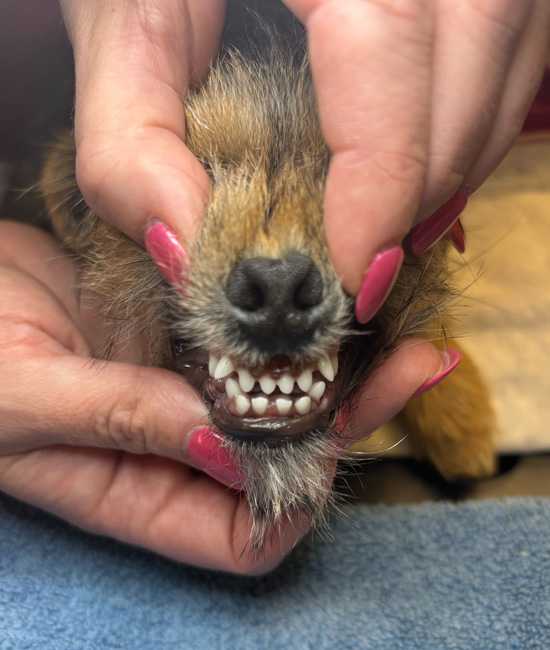Interventional Dentistry
Interventional Dentistry is a term used to describe making adjustments in the mouth to prevent problems before they happen. This includes pulling puppy teeth when they don’t fall out by the time they should, placing bite planes to prevent teeth from jabbing into the gums, and pulling adult teeth if they are causing crowding issues.
Please note that the procedures listed below need to be performed under anesthesia. Your veterinarian will give you an estimated cost of services if your pet requires one or more of these procedures.
Dangers of Anesthesia-Free Cleanings
Although it may seem more cost effective, anesthesia-free dentistry is only a cosmetic change for a deeper issue. Anesthesia-free cleanings are…
Ineffective – This cosmetic-only service does not remove the plaque and tartar from below the gum line – where dental disease occurs! Fractured, infected teeth and other issues are also ignored.
Dangerous – Sudden movements by an awake patient may result in injury to your pet as dental instruments are very sharp. Also, without airway protection, your pet may breath bacterial-laden plaque and calculus into the lungs.
Stressful – Your pet cannot understand the procedure being performed and why he/she must be restrained for so long.
Painful – Without anesthesia or sedation, your pet feels everything. Ouch!
Not a professional health service – Most people offering anesthesia free cleanings do not know how to safely use sedative and anesthetic drugs or how to monitor your pet under anesthesia. If you come across a company that says they will “anesthetize” or “sedate” your pet and they are not a licensed veterinarian, they may be putting your pet in danger.
Please talk to your veterinarian about your pet’s dental health. Our doctors are highly trained to understand the oral health of dogs and cats and can help you do what is best for your pet.
Oral Surgery
For your pet, dental disease can be painful and can cause illness throughout the entire body. Dental disease is a build-up of bacteria in the mouth that causes infection. Oral Surgery procedures are classified as Level 1 through Level 4, Minor Periodontal Disease though Extensive Periodontal Disease. These levels are estimates given by doctors, and may change once the dental procedure has started.
Included in All of Our Oral Surgery
- Pre-operative blood coagulation profile
- Pre-operative exam
- IV catheter and fluids
- Pre-anesthetic sedation and pain medication
- General anesthesia with comprehensive monitoring including ECG, O2 saturation, blood pressure, etc.
- Hand and ultrasonic scaling and polishing
- Periodontal probing and charting
- Full mouth radiographs (x-rays)
- Local nerve blocks for extractions
- Antibiotic injections
- Class IV laser therapy
- Pain medications to go home
- Antibiotics to go home
- Nail trim home care kit
- Detailed home care report
Included in All of Our Oral Surgery
- Pre-operative blood coagulation profile
- Pre-operative exam
- IV catheter and fluids
- Pre-anesthetic sedation and pain medication
- General anesthesia with comprehensive monitoring including ECG, O2 saturation, blood pressure, etc.
- Hand and ultrasonic scaling and polishing
- Periodontal probing and charting
- Full mouth radiographs (x-rays)
- Local nerve blocks for extractions
- Antibiotic injections
- Class IV laser therapy
- Pain medications to go home
- Antibiotics to go home
- Nail trim home care kit
- Detailed home care report
Treatments
The number and complication of the teeth that need treatment will determine the level of the procedure needed for your pet. Treatments can include extraction, Doxirobe gel (antibiotic gel to treat pockets around loose teeth), and/or bonded sealant (seal placed over pulp cavity of a broken or chipped tooth to prevent infection from entering).

Photo credited to Hajirah Awan






